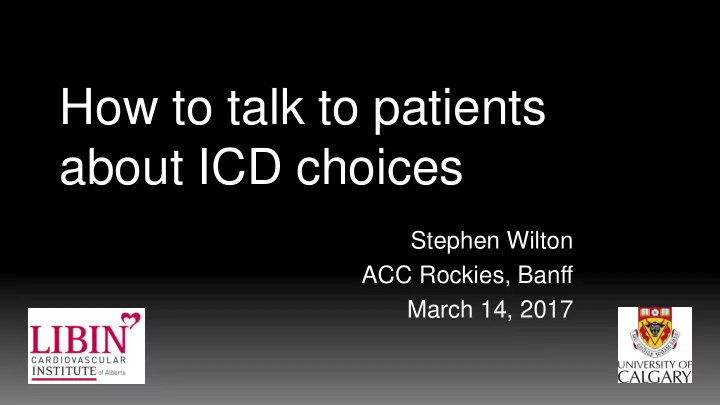

How to talk to patients about ICD choices Stephen Wilton ACC Rockies, Banff March 14, 2017
Disclosures Research Support • Medtronic Canada, Boston Scientific Consulting/Honoraria • Arca Biopharma, Boehringer-Ingelheim I do not implant CIEDs
Objectives • Review Canadian 1 ry prevention ICD Guidelines • Review knowledge gaps • Discuss effective risk communication principles • Discuss patient selection: roles of comorbidity, frailty, patient preferences • List helpful resources • *CRT, Secondary prevention and special situations not covered
CCS ICD Guidelines 2016 Bennett, CJC, 2016
CCS ICD Guidelines 2016 Bennett, CJC, 2016
Evidence overview • 7 primary prevention trials (N=4,981, excl CABG, post-MI) • Pooled RRR for all cause mortality: 0.76 • Pooled ARR for all cause mortality: 7.9%, NNT = 13 Limitations • Need to incorporate baseline risk, inter-patient variability • Generalizability Nanthakumar, JACC, 2004, Betts, Europace, 2013
RCT Evidence – SCD-HeFT Placebo: 36% @ 5y ICD: 29% @ 5y Alive due to ICD: 7% Bardy, NEJM, 2005
Patient Perceptions of ICD benefits Interviews of ICD recipients What is the purpose of the ICD? N=69 To improve breathing? 52% To improve pump function of the heart? 61% To prevent heart attack? 65% To reduce risk of suddenly stopping breathing? 48% To improve ability to exercise? 50% To terminate arrhythmia 0% Groarke, PACE, 2012
Patient Perceptions of ICD benefits Survey of 105 Primary prevention ICD recipients or ICD-eligible Stewart , J Card Fail , 2010
Tips for Effective Risk Communication • Use Quantitative rather than Qualitative descriptors • Present statistical info using Absolute , not Relative risk • Highlight incremental versus baseline risk • Use Pictographs to display risks and benefits Lin and Fagerlin, Circ CV Outcome, 2014
Data overview Stevenson, LW , J Card Fail , 2006
Patient Selection – Basic Principle Risk of non-sudden death Risk of sudden death 5 Years Challenge Enrich ICD population for sudden vs. non-sudden death
Patient Selection – Role of Age • Pooled analysis of 5 RCTs • N=390 Age >75 • Decreasing ICD benefit with increasing age Hess, Circ:Quality and Outcome, 2015
Patient Selection – role of NYHA Class Miller, CJC , 2015
Patient Selection – Role of comorbidities • Individual patient meta-analysis (MADIT I&II, SCD-HeFT, DEFINITE) Steinberg, JACC:HF, 2014
Patient Selection – What about NICM? DANISH Køber, NEJM, 2016 Golwala, Circ, 2017
Patient Selection – Role of Frailty
Patient Selection – Role of Frailty • Decreased reserve & increased vulnerability to stressors • Overlap with, but independent of age and comorbidities • Slowness: 5m gait speed • Weakness: grip strength, time to stand from chair • Shrinking: weight loss, sarcopenia • Inactivity • Exhaustion
Putting it together – Clinical Prediction Scores • Models to identify those likely to SHOCKED ( Bilchick, JACC, 2012 ) die despite an ICD • Age ≥75 • Based on RCTs and registries • NYHA 3 • Seattle HF Model, Charlson • AF Comorbiditiy Index can be used • COPD • CKD • LVEF ≤ 20% • DM • C-stat = 0.75
SHOCKED Score Nomogram - examples 1. 76 yo male with ischemic CM, LVEF 28%, sinus rhythm, NYHA Class 2, no other significant comorbidities – Total points = 62, 4-year survival ~74% 2. 76 yo male with ischemic CM, LVEF 15%, persistent AF, CKD and DM – Total points = 251, 4-year survival ~ 21%
Shocks versus Death – Ontario ICD registry • N = 3,445 Primary prophylaxis ICD recipients • Competing risk models for ICD shock and all-cause death Lee, Circ HF, 2015
Shocks versus Death – Ontario ICD registry Lee, Circ HF, 2015
Clinical Prediction Scores – What could go wrong?
Patient Selection Risk of complications Risk of non-arrhythmic Risk of sudden death death Risk of psychological distress Burden of Follow-up
What influences patient’s ICD decisions? Yuhas, PACE, 2012
Patient Decision Aids • Summarize benefits, risks and alternatives of treatments • Pre-visit or in-visit models • Improve knowledge and decisional confidence • Best for elective decisions involving significant trade-offs • ICD Decision Aids • https://www.healthlinkbc.ca/health-topics/uf9848#uf10122 • http://optiongrid.org/option-grids/grid-landing/43
Option Grid ICD Decision Aid
Option Grid ICD Decision Aid
Option Grid ICD Decision Aid
Objectives • Review Canadian 1 ry prevention ICD Guidelines • Review knowledge gaps • Discuss effective risk communication principles • Discuss patient selection: roles of comorbidity, frailty, patient preferences • List helpful resources
Take Home Points • ICD decision-making can be complex • There is time, so take it – Understand patient knowledge, goals, expectations – Communicate realistic benefit and risk information • Standardized, quantitative risk communication can help • Individualizing risk predictions has promise – Need better tools
Recommend
More recommend